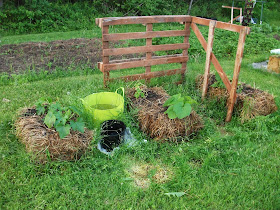In determining the most appropriate location for plants, there are some obvious factors to consider such as the amount of sunlight or the depth of the soil (some carrots were slightly bent at the end as the raised garden bed was not quite deep enough).
An obvious factor which somehow eluded me
last year is the eventual size of the plants. The winter squash grew so large that the
vines were growing throughout the herb garden and along the space set aside for
walking paths.
And the summer squash that I had planted in hay bales grew so large that the hay bale collapsed under the weight (luckily the root was secure and the plants continued to grow, although somewhat lopsided).
It’s easy to forget about size when you are planting a little 4 inch seedling in the spring. These are those same hay bales when I first planted those monster zucchini plants:
The hay bale gardening worked really well for me and it allows me to situate plants anywhere I want (so long as the location is chosen right at the beginning – once they are waterlogged, they are near impossible to move). I have managed to get a lot more hay (well, straw actually) bales this year thanks to a friend who loaned me his truck - so lots of options for location!
And the summer squash that I had planted in hay bales grew so large that the hay bale collapsed under the weight (luckily the root was secure and the plants continued to grow, although somewhat lopsided).
It’s easy to forget about size when you are planting a little 4 inch seedling in the spring. These are those same hay bales when I first planted those monster zucchini plants:
The hay bale gardening worked really well for me and it allows me to situate plants anywhere I want (so long as the location is chosen right at the beginning – once they are waterlogged, they are near impossible to move). I have managed to get a lot more hay (well, straw actually) bales this year thanks to a friend who loaned me his truck - so lots of options for location!
Slightly more complex considerations for
location are crop rotation and companion planting. Crop rotation itself is not a difficult
concept as far as the sequence goes – it is easy enough to find resources that
indicate which vegetables are best suited to follow other vegetables to improve
soil conditions and prevent unwanted pests.
The challenge is more about size.
I use a much larger space for potatoes and squash than I would for, say,
beans, beets or broccoli making it difficult to simply swap or rotate. But for the limited amount of veggies I grow,
crop rotation is not as much about soil management as it is about pest
control. Luckily I did not have any
potato bugs last year, but once they’ve found a patch, you definitely want to
move your plants as they’ll keep coming back!
So I won’t worry about rotating too much this year but will ensure the
veggies with the worst pests are moved around.
Companion planting is an ongoing thought
process. I am definitely going to
interplant more nasturtiums, sunflowers and marigolds in the vegetable patches as they can
help deter (or attract away from the vegetable) certain pests. But it is also important not to plant certain
vegetables near each other or, equally, purposely plant vegetable plants near
each other for many reasons with pest control being just one of them.
This is still a learning process for me and I will continue to research this subject. There seem to be many websites available but if anyone has a favourite website or other resource for companion planting specifically for backyard vegetable gardens it would be appreciated as I am relying entirely on what I read with no practical experience ...
Happy gardening!
This is still a learning process for me and I will continue to research this subject. There seem to be many websites available but if anyone has a favourite website or other resource for companion planting specifically for backyard vegetable gardens it would be appreciated as I am relying entirely on what I read with no practical experience ...
Happy gardening!








No comments:
Post a Comment